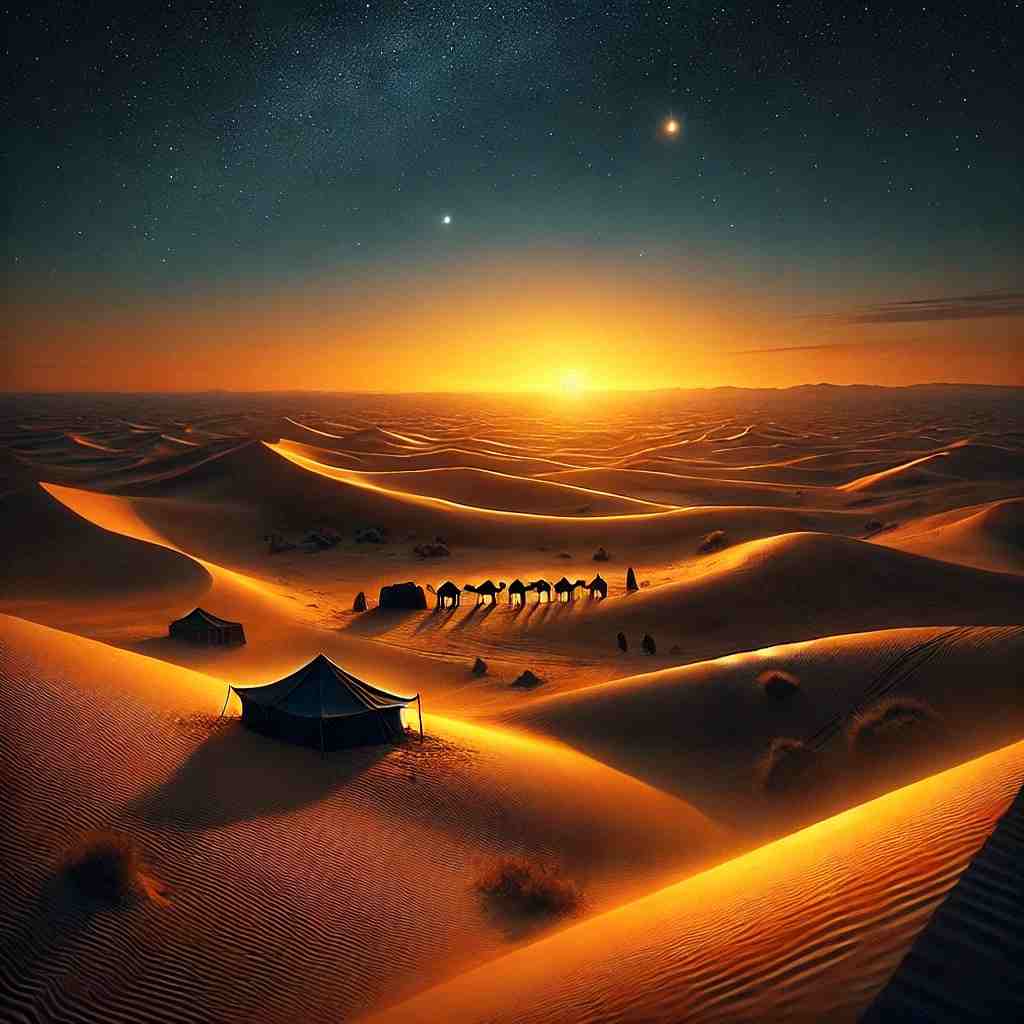The Desert (Tamasheq)
Amastan Ag Mohamed
1803 to 1878

Want to track your favorites? Reopen or create a unique username. No personal details are required!
Aẓuf
Aẓuf d assine-nnegh,
It-tut amaḍan, it-tut taddart.
Ilewwiwen nagh innaggen, ad ittu,
Tikttatin-nnegh, teṭṭayen ɣef afaggan.
Iɣesan n aẓuf id-sawal di sdu,
Tafat tessawalen s wanan,
Netta id inekin ad t-tayegh,
Ad nerrar ɣefnettid, id dan ittu.
Amastan Ag Mohamed's The Desert
Amastan Ag Mohamed’s poem The Desert captures the complex relationship between the Tuareg people and their environment, exploring themes of survival, belonging, and reverence for nature through a compact and richly symbolic free-verse structure. Written in Tamazight, the language of the Tuareg people, the original and its translation offer insights into how place and identity intertwine in this community’s worldview.
Introduction
The Desert is at once an expression of cultural identity and a tribute to the desert, personified here as both a nurturing home and a mysterious, almost spiritual guide. Through simple yet evocative language, Mohamed invokes a tone of reverence, showing that the desert, though harsh, provides sustenance and guidance. The poem’s structure and imagery embody the respect and dependency that define life in this unforgiving landscape.
Stanza 1: The Desert as Home and Sustainer
In the opening lines, the desert is presented not merely as a setting but as "our home," establishing a close bond between the people and the land. The phrase "It gives us water, it gives us life" suggests that the desert, while sparse, is generous in its own way, providing for those who understand how to live within its constraints. This line resonates deeply with the Tuareg’s adaptive resilience in the Sahara, a region that might appear desolate to outsiders but is regarded as life-giving by those who know its rhythms.
The presence of camels and tents—essential elements of desert life—serves to ground the poem in specific cultural practices. Camels "graze and wander," an image that subtly highlights the need for both constancy and flexibility in the desert; the camels’ roaming reflects the nomadic lifestyle of the Tuareg. Meanwhile, the tents "stand against the wind," a phrase that symbolizes resilience and community, suggesting that Tuareg society is equipped to withstand not only physical challenges but also the metaphorical "winds" of hardship.
Stanza 2: Mysticism and Navigation in the Desert
The second stanza shifts from the physical sustenance provided by the desert to the spiritual and existential relationship the Tuareg people share with it. "The sand speaks in silence" captures the profound quiet of the desert, which is often seen as a place of reflection and solitude. This line invites readers to consider the hidden depths within the seemingly barren sands, perhaps suggesting that the desert, though silent, holds wisdom or a kind of ancient memory for those who know how to listen.
"The sun blazes with truth" is a striking metaphor, equating the sun's harshness with an uncompromising reality. Here, Mohamed seems to acknowledge that life in the desert requires a confrontation with harsh truths about survival and the limits of human power. The sun, in its intensity, reveals things as they are, without artifice, reflecting an acceptance of the raw conditions of desert life.
The final two lines, "We follow the stars in darkness, / And walk where they lead us," introduce a motif of guidance and navigation. The stars have long been essential for navigation in the desert, but here they seem to symbolize more than physical direction. The stars' guidance might be read as a metaphor for spiritual or cultural orientation, an assertion that the Tuareg find their way not only through the physical desert but through life by relying on traditional knowledge, passed down through generations. These lines evoke a quiet determination, suggesting that, even in the darkness, there is a path forward, illuminated by the wisdom of the past.
Language and Cultural Resonance
The original Tamazight title, "Aẓuf," can be roughly translated to "desert" or "emptiness," though it holds deeper cultural nuances. This term encapsulates the paradox of the desert: a place that may appear empty but is filled with meaning and life for those who dwell there. The language here resonates with Tuareg values of patience, endurance, and respect for nature, allowing readers to glimpse the worldview of a people shaped by the vast, challenging landscape around them.
Conclusion
In The Desert, Amastan Ag Mohamed crafts a portrait of the Tuareg’s harmonious relationship with their environment, celebrating both the material and spiritual sustenance that the desert provides. Through precise, reverent language and the effective use of cultural symbols, the poem underscores the idea that the desert, though seemingly barren, is a place of life, wisdom, and direction. Mohamed’s poem invites readers to respect and reimagine the desert as more than a wilderness, instead viewing it as a home with its own silent language and guidance for those who are willing to listen and follow its path.
Note: Amastan Ag Mohamed is a fictional character, created to embody the spirit of a possible author of the traditional Tuareg poem "The Desert." His story was invented to bring to life the vibrant oral tradition of the Tuareg people.
This text was generated by AI and is for reference only. Learn more

